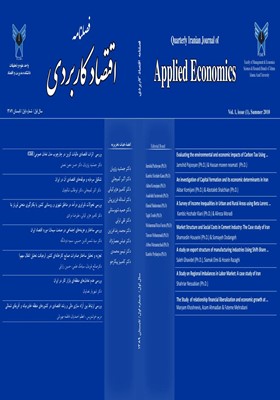بررسی ساختار و هزینههای اجتماعی در صنعت سیمان؛ مورد اقتصاد ایران
محورهای موضوعی : اقتصاد کاربردیسید شمس الدین حسینی 1 * , سمیه دودانگه 2
1 - ندارد
2 - مسئول مکاتبات
کلید واژه: ساختار بازار, تمرکز, شاخص هرفیندال – هیرشمن, هزینه اجتماعی انحصار سیمان, الگوی دادههای تلفیقی,
چکیده مقاله :
مقاله حاضر به بررسی ساختار و عملکرد بازار سیمان در طول دوره 86-1379 می پردازد. نتایج محاسبه با لحاظ اثر مالکیت نشان می دهد که در دوره مورد بررسی، نسبت تمرکز چهار بنگاه برتر بین 74 تا 84 درصد، شاخص هرفیندال هیرشمن بین 2018 تا 2501 واحد و شاخص آنتروپی بین 74/0 تا 83/0 در نوسان بوده اند. این درحالی است که ارقام شاخص های مربوطه بدون لحاظ اثر مولفه مالکیت، نتایج فوق را تأیید نمی کنند. در ادامه بررسی، هزینه های اجتماعی عملکرد در صنعت سیمان با استفاده از روش کالین- مولر اندازهگیری شده است. در انجام این محاسبه، تابع هزینه صنعت سیمان در قالب یک الگوی داده های تلفیقی (به تفکیک 10 بنگاه و برای دوره 86-1379 ) تخمین زده شده، سپس با محاسبه هزینه نهایی از تابع مذکور به محاسبه انحراف قیمت از هزینه نهایی به تفکیک هر یک از کارخانجات و در نهایت محاسبه هزینه های رفاهی عملکرد این صنعت پرداخته شده است. نتایج حاصل از محاسبات فوق نشان می دهد که رفاه از دست رفته ناشی از انحصار در این صنعت (از سوی 10 بنگاه)، 44 درصد ارزش فروش می باشد. افزون بر این، در برآورد هزینه نهایی و هزینه متوسط در این صنعت، صرفه اقتصادی نسبت به مقیاس مشاهده می شود.
This paper aims to highlight the structure of cement market in Iran and show how it has performed in the past, particularly over period of 2000 - 2007. Following the new policy guidelines notified by the supreme leader of Iran, I republic, pertaining the article 44 of The Constitution, it deemed necessary to carry out studies evaluating the viability these corporation exposed to market forces. The rationale behind this new policy was to expedite the divestment process of state owned corporations to private entities as a step to enhance an environment of competitiveness in the economy, and also to promote productivity , social welfare and so forth, As such, this study aims to fill this gap. To delineate the structure of Cement market, techniques such as Concentration index, Hirfindal-Hirshman index, and Entropy (both cases of including not including ownership effect) indexes are used. In the case Entropy including ownership effect, the result shows that over the period under study, the concentration ratio of top four firms were between 74 and 84 percent, and that of Herfindhal-Hirshman index was between 2018 and 2501 unit and Entropy index was between 0.74 and 0.83. In the case Entropy excluding ownership effect, the above observation can not be maintained. To measure social cost inflicted by Cement Industry Activities, Cowling-Mueller Method, was used. Cost function for cement industry (comprising of 10 firms) was estimated in an Integral Data Pattern Format using data covering the period of 2000 to 2007. Then, based on the information, the total cost of above mentioned firms, their price deviation from total cost, and the total welfare costs of the industry as a whole were calculated. The results of above calculations show that the welfare loss resulted from monopoly of these 10 firms, amounts to 44 percent of sale value. Moreover, economics of scale was taken care of while estimating marginal cost and average cost in this industry.

